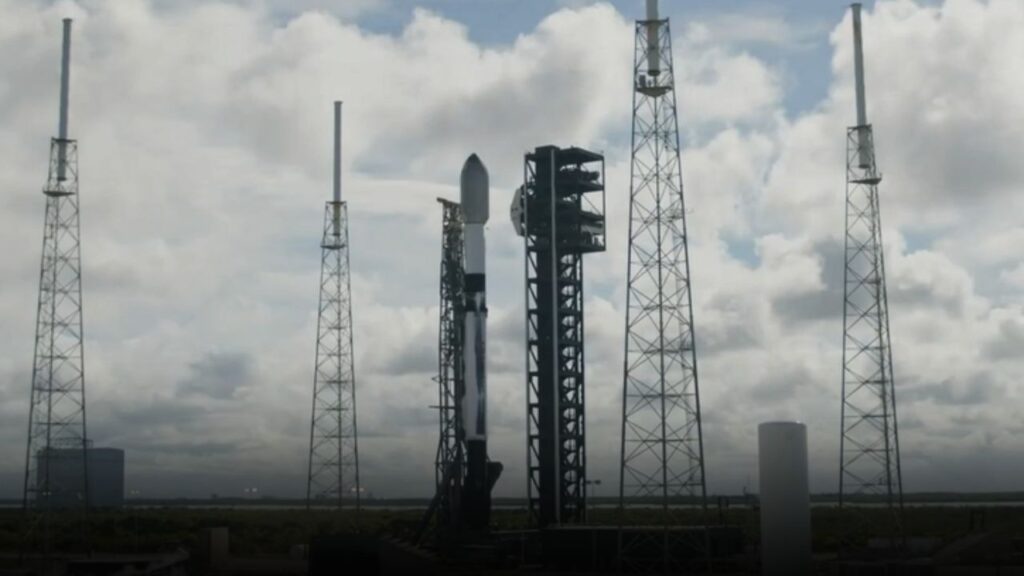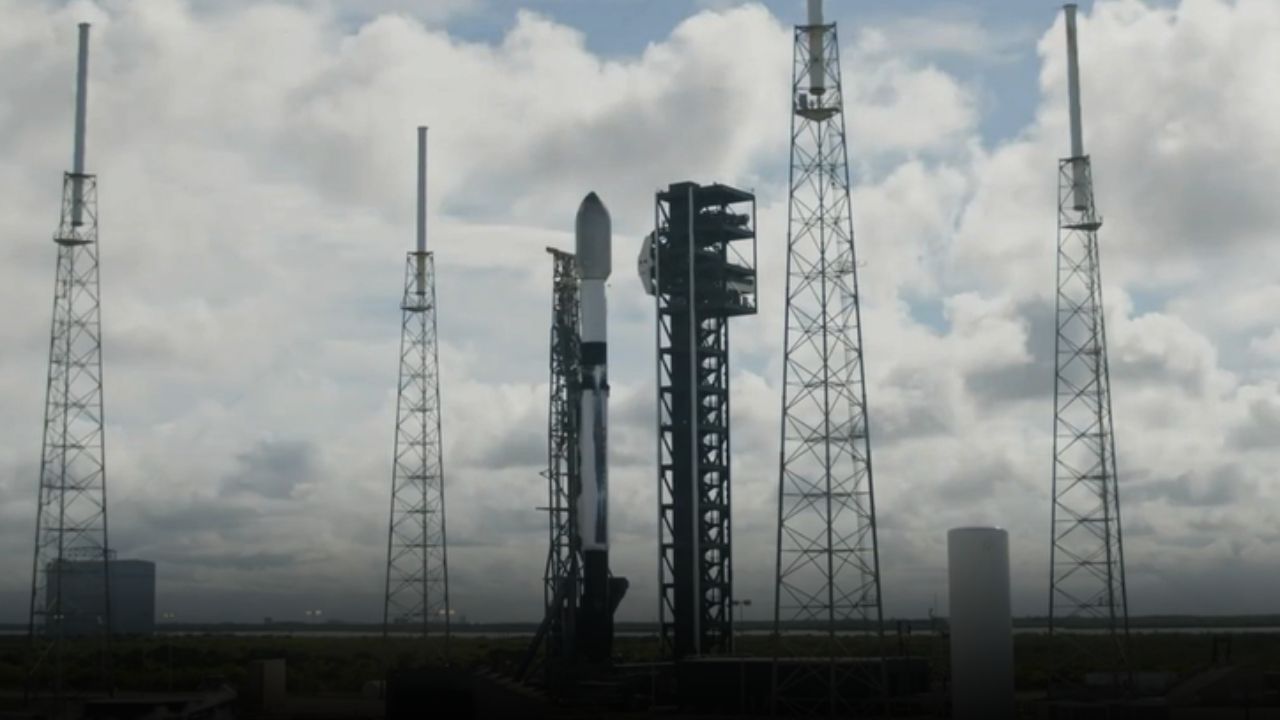SpaceX Starlink mission, SpaceX launch delayed, Starlink satellites, SpaceX Falcon 9, weather delay SpaceX, direct-to-cell satellites, reusable rocket booster, Polaris Dawn mission, SpaceX satellite internet, SpaceX news
SpaceX postponed its Starlink satellite launch on Wednesday due to poor weather conditions in the Atlantic Ocean. The mission, now rescheduled for Thursday, aims to deploy 21 Starlink satellites, including 13 with direct-to-cell capabilities. Learn more about this mission and upcoming SpaceX crewed missions.

SpaceX Scrubs Wednesday’s Starlink Mission Due to Weather; Launch Rescheduled for Thursday
On Wednesday, SpaceX was preparing for yet another mission as part of its ambitious Starlink satellite project, aimed at providing global internet coverage. However, unfavorable weather conditions forced the private space exploration company to scrub the launch. The mission, which was scheduled to take place from Cape Canaveral in Florida, was to carry 21 Starlink satellites, including 13 equipped with direct-to-cell capabilities, but it was postponed due to unsafe conditions in the booster recovery area.
A Glimpse Into SpaceX’s Starlink Project
Starlink, a division of SpaceX, is a satellite-based internet system designed to provide high-speed internet access to remote and underserved areas around the globe. The system is comprised of a constellation of small satellites in low Earth orbit (LEO) that communicate with designated ground transceivers.
Since its first launch in 2019, SpaceX has been steadily deploying Starlink satellites, with over 4,000 satellites already in orbit. The ultimate goal is to have tens of thousands of satellites in space, forming a vast network that will deliver internet services to even the most remote corners of the planet.
The planned Wednesday launch would have been another important step in the expansion of this network, with the inclusion of 21 new satellites, 13 of which are equipped with direct-to-cell capabilities. This feature is designed to provide direct cellular connectivity in remote regions where traditional ground-based networks are not available, further enhancing Starlink’s global reach.
The Scrub: Why Weather Matters in Space Missions
Space launches are complex endeavors that require favorable conditions not only for liftoff but also for the entire mission, including the return of reusable components like the first-stage booster. SpaceX’s decision to delay the Starlink mission was prompted by unfavorable weather conditions in the booster recovery area in the Atlantic Ocean, where the company intended to land the Falcon 9’s first-stage booster on a drone ship.
The Falcon 9 rocket’s first-stage booster was set to make its 15th flight, a significant milestone in SpaceX’s effort to build reusable rockets. Reusability is key to SpaceX’s business model, allowing the company to reduce costs and make space missions more affordable. This particular booster had flown eight previous Starlink missions and was expected to land on the drone ship stationed in the Atlantic. However, weather conditions, such as high winds or rough seas, can pose serious risks to the booster’s landing, making a successful recovery difficult or even impossible.
Given the importance of recovering the booster intact for future use, SpaceX opted to delay the mission until conditions improved. While this decision might seem minor to casual observers, it underscores the challenges inherent in launching rockets, even for a company as experienced as SpaceX.
Starlink Satellites with Direct-to-Cell Capabilities
Among the 21 Starlink satellites aboard this mission, 13 have been equipped with direct-to-cell capabilities, an exciting development in the world of satellite internet. This new technology aims to provide cellular connectivity to users in remote areas without the need for traditional cell towers. Instead, satellites will beam signals directly to cell phones and other devices, making it possible for people in isolated locations to access cellular networks.
This capability has the potential to revolutionize telecommunications in rural areas, particularly in developing countries where infrastructure is limited. It could also be invaluable during natural disasters or emergencies, when traditional networks are often knocked offline. The ability to provide direct-to-cell services from space represents a major leap forward for the Starlink project and could significantly expand its user base.
Falcon 9 Booster Reuse: A Game-Changer for SpaceX
One of the most notable aspects of the Starlink mission is the planned recovery of the Falcon 9 rocket’s first-stage booster. This particular booster had already completed 14 missions, making this its 15th flight. Its track record includes eight previous Starlink satellite launches, showcasing SpaceX’s expertise in reusing rockets.
The ability to reuse rocket components is a cornerstone of SpaceX’s business model and is a key factor in reducing the cost of space missions. By recovering and refurbishing rockets after each flight, SpaceX can significantly lower the cost of future missions. This has allowed the company to launch satellites and transport cargo to the International Space Station (ISS) at a fraction of the cost of traditional rocket systems.
In recent months, however, SpaceX has encountered some challenges with booster recoveries. Last week, a first-stage booster tipped over and caught fire after landing on a drone ship during a Starlink mission, prompting an investigation. Despite such setbacks, the company remains committed to refining its technology and ensuring the reliability of its reusable rockets.
SpaceX’s Crew Mission: Polaris Dawn
While the weather delay of the Starlink mission was disappointing, SpaceX is still gearing up for another major launch just a day later. On Thursday, the company is set to launch its highly anticipated Polaris Dawn mission. This mission will feature a crew of four civilian astronauts, marking yet another milestone in the burgeoning field of commercial spaceflight.
The Polaris Dawn mission is particularly noteworthy for its goal of reaching extreme orbital altitudes and conducting the first-ever private spacewalk. During their time in space, the astronauts will also conduct a series of scientific experiments, further expanding humanity’s knowledge of space exploration. The mission is part of SpaceX’s broader effort to push the boundaries of human space travel and pave the way for future commercial and scientific endeavors beyond Earth’s atmosphere.
The crewed mission reflects SpaceX’s growing role in not only launching satellites and cargo into space but also enabling human space exploration. With missions like Polaris Dawn, SpaceX is helping to make space more accessible to private individuals, scientists, and commercial enterprises alike.
The Broader Impact of SpaceX’s Efforts
SpaceX’s achievements with reusable rockets, its Starlink satellite network, and crewed missions like Polaris Dawn represent a significant shift in the landscape of space exploration. Historically, space exploration has been dominated by government agencies like NASA and the Russian space agency Roscosmos. However, private companies like SpaceX are increasingly playing a leading role in the space industry, pushing the boundaries of what is possible and making space exploration more cost-effective.
One of SpaceX’s most notable contributions to the field is its focus on reusability. Traditionally, rockets have been discarded after a single flight, making space missions extremely expensive. By recovering and reusing rockets, SpaceX has significantly lowered the cost of launching satellites, cargo, and even people into space. This has made space more accessible to a wider range of stakeholders, from private companies to scientific institutions.
Additionally, the Starlink satellite project has the potential to revolutionize global communications. By providing high-speed internet access to remote and underserved areas, Starlink could help bridge the digital divide and improve access to information for millions of people around the world. The inclusion of direct-to-cell capabilities further enhances this potential, allowing Starlink to provide connectivity even in areas without traditional telecommunications infrastructure.
SpaceX’s efforts also have important implications for future space exploration. With crewed missions like Polaris Dawn, the company is helping to pave the way for future missions to the Moon, Mars, and beyond. By refining the technology needed to send humans into space and return them safely to Earth, SpaceX is contributing to humanity’s long-term goal of becoming a multi-planetary species.
Conclusion
SpaceX’s decision to scrub the Wednesday Starlink mission due to unfavorable weather conditions is a reminder of the complexities and challenges involved in space exploration. Despite the setback, SpaceX continues to push forward with its ambitious plans, including the launch of the crewed Polaris Dawn mission just a day later.
The Starlink project, with its goal of providing global internet coverage, represents a major leap forward in satellite communications. With the inclusion of direct-to-cell capabilities, Starlink is poised to revolutionize telecommunications in remote areas. At the same time, SpaceX’s focus on reusability is helping to make space missions more cost-effective and accessible.
As SpaceX continues to innovate and refine its technology, it is playing a key role in shaping the future of space exploration. From satellite internet to human spaceflight, SpaceX is helping to make space more accessible and pushing the boundaries of what is possible in the final frontier.
Read More
